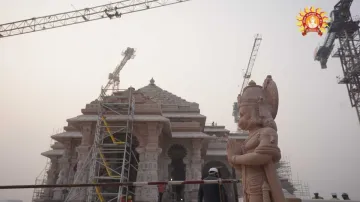Ayodhya: Ram Janmabhoomi Teerth Kshetra Trust has shared the first pictures of the magnificent Sinh Dwar of Shri Ram Janmabhoomi Mandir, ahead of the grand opening on January 22. The latest photos show idols of Elephant, Lion, Garun Dev and Lord Hanuman.
The grand 'Pran Pratishtha' ceremony of the Ram Temple will be attended by PM Modi, Uttar Pradesh Chief Minister Yogi Adityanath, over 4,000 saints, among other dignitaries.
Ram Janmabhoomi Teerth Kshetra Trust shared new photos of the Ram Temple showing the magnificent Sinh Dwar.
Features of Shri Ram Janmbhoomi Mandir
- The three-storied Mandir is in the traditional Nagar style. It has a length (east-west) of 380 feet, a width of 250 feet, and a height of 161 feet. Each floor is 20 feet tall. It has a total of 392 pillars and 44 doors.
- In the main sanctum sanctorum, there is the childhood form of Bhagwan Shri Ram (the idol of Shri Ram Lalla) and on the first floor, there will be a Shri Ram Darbar. Near the Mandir is a historic Well (Sita koop), dating back to the ancient era.
- It will have five mandaps (Hall) - Nritya Mandap, Rang Mandap, Sabha Mandap, Prarthna and Kirtan Mandaps. Statues of deities, gods, and goddesses adorn the pillars and walls.
- Entry is from the east, ascending 32 stairs through the Sinh Dwar. Provision of ramps and lifts for the convenience of the differently-abled and elderly. The Parkota (Rectangular compound wall) with a length of 732 meters and a width of 14 feet, surrounds the Mandir. A look at Singh Dwar of the Ram Temple in Ayodhya.
- At the four corners of the compound, there are four Mandirs - dedicated to Surya Dev, Devi Bhagwati, Ganesh Bhagwan and Bhagwan Shiv. In the northern arm is a Mandir of Maa Annapurna and in the southern arm is a Mandir of Hanuman ji.
- In the Shri Ram Janmbhoomi Mandir complex, there are proposed Mandirs dedicated to Maharshi Valmiki, Maharshi Vashishtha, Maharshi Vishwamitra, Maharshi Agastya, Nishad Raj, Mata Shabri, and the revered consort of the Devi Ahilya. In the southwestern part of the complex, at Kuber Tila, the ancient Mandir of Bhagwan Shiv has been restored, along with the installation of Jatayu.
- No iron is used anywhere in the Mandir. The foundation of the Mandir has been constructed with a 14-meter-thick layer of roller-compacted concrete (RCC), giving it the appearance of artificial rock. For protection against ground moisture, a 21-foot-high plinth has been constructed using granite.
- The Mandir complex has a sewage treatment plant, water treatment plant, water supply for fire safety and an independent power station. View of the grand Ram Temple in Ayodhya.
- A Pilgrims Facility Centre (PFC) with a capacity of 25,000 people is being constructed, it will provide medical facilities & Locker facility to the pilgrims. The complex will also have a separate block with bathing area, washrooms, washbasin, open taps, etc.
- The mandir is being onstructed entirely using Bharat’s traditional and indigenous technology. It is being constructed with particular emphasis on environmental-water conservation with 70% of the 70-acre area being left green.
ALSO READ | Ayodhya gets electric cars for public transport: Check fare, other details
